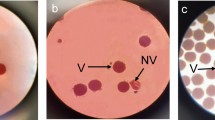Abstract
To establish the feasibility of hybridization between the wild carrot species Daucus pusillus Michx. (2n = 2x = 22; 2n = 2x = 22 and 20), collected in the pampas grasslands of Argentina, and the edible carrot, Daucus carota L. (2n = 2x = 18), controlled pollinations were attempted on the plant. Due to the difficulties encountered, flowers of 12 accesions and three commercial cultivars were excised from individual plants and pollinated in Petri dishes following an incomplete diallel design. After processing, the pollinated pistils (four to six per genotypic combination) were observed under a microscope with UV light. Pollen tubes reaching the ovaries and/or the ovules (compatible relation) were observed in six out of nine D. pusillus × D. pusillus and seven out of 18 D. pusillus × D. carota genotypic combinations. In the eight D. carota × D. pusillus genotypic combinations, only ungerminated pollen, pollen not adhered to the stigmas or pollen tubes overlapping the stylar tissue were observed. Additional flowers were pollinated in a sample of compatible genotypic combinations and the pollinated pistils were in vitro culture to study embryo and endosperm development. Eight out of nine pistils from the intraspecific and nine out of 13 from the interspecific crosses enlarged to form apparently normal schizocarps. Histological analyses revealed normal development of embryo and endosperm. The breeding barriers between the two species are incomplete, making feasible the obtainment of interspecific hybrids by conventional techniques.


Similar content being viewed by others
Notes
Some plants with around 90% of the cells with 2n = 22 and 10% of the cells with 2n = 20 (aneusomaty)
References
Cabrera AL (1953) Manual de la Flora de los alrededores de Buenos Aires. Ed. ACME, Buenos Aires
Cabrera AL (1965) Flora de la provincia de Buenos Aires, parte IV. Colección Científica del INTA, Buenos Aires
Cabrera AL, Zardini EM (1978) Manual de la flora de alrededor de la provincia de Bs. As. 2nd edn Ed. ACME, Buenos Aires
Camadro EL, Cauhépé MA, Simon PW (2007) Geographical distribution of wild Daucus species in the natural grasslands of the Argentinian pampas. Genetic Res Crop Evol. DOI 10.1007/s10722-006-9162-9
Correa Maevia N (1988) Flora Patagónica. Parte IV. Colección Científica. INTA, Buenos Aires
Martin FW (1958) Staining and observing pollen tubes in the style by means of fluorescence. Stain Technol 34:125–128
Marzocca A (1957) Manual de Malezas. Imprenta y Casa Editora LONI, Buenos Aires
Mursahige T, Skoog F (1962) A revised medium for rapid growth and bioassays with tobacco tisue cultures. Physiol Plant 15:473–497
Rubatzky VE, Quirós CF, Simon PW (1999) Carrots and related vegetable Umbelliferae. Crop production science in horticulture 10. CABI Publishing, Oxon, UK
Sass JE (1952) Elements of Botany microtechnique. Mc Graw-Hill, London
Scheifele GL, Nelson RR, Koons C (1970) Increased susceptibility to southern leafspot (Helminthosporium maydis) in inbred lines and hybrids of maize with Texas male-sterile cytoplasm.Plant Disease Report 54:501–503
Vervoorst FB (1967) La vegetación de la República Argentina. VII. Las comunidades vegetales de la Depresión del Salado. Serie fitogeográfica N°7, INTA, CNIA, Buenos Aires
Acknowledgements
This research is part of an INTA-USDA Cooperative Agreement (USDA Extramural Agreement 58-3655-3-F1729) and was financed by both institutions.
Author information
Authors and Affiliations
Corresponding author
Rights and permissions
About this article
Cite this article
Camadro, E.L., Cauhépé, M.A. & Simon, P.W. Compatibility relations between the edible carrot Daucus carota and D. pusillus, a related wild species from the Argentinian Pampas. Euphytica 159, 103–109 (2008). https://doi.org/10.1007/s10681-007-9462-y
Received:
Accepted:
Published:
Issue Date:
DOI: https://doi.org/10.1007/s10681-007-9462-y




